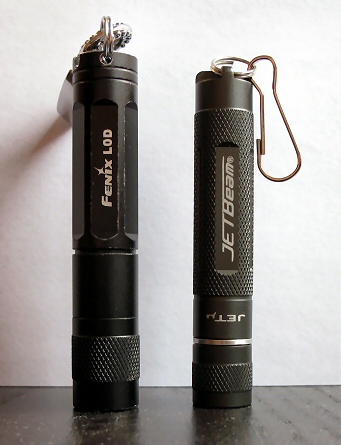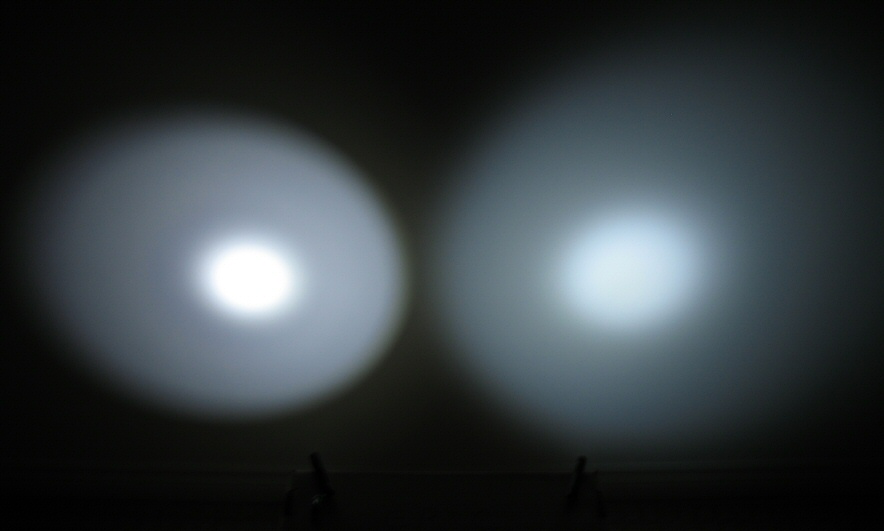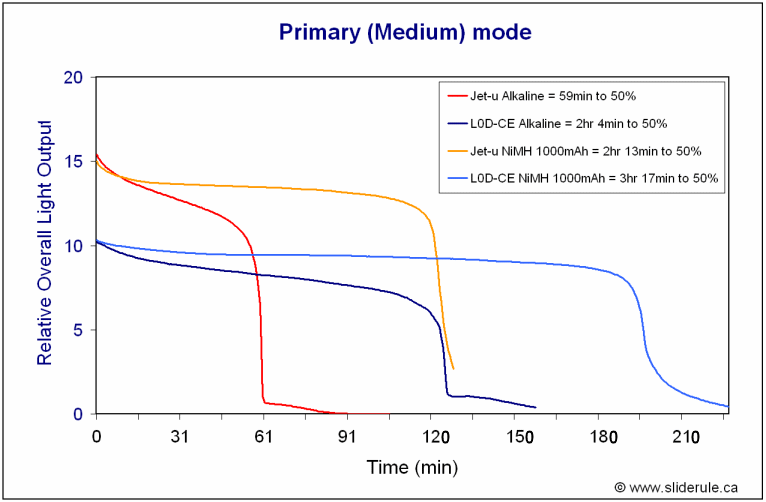Jetbeam Jet-µ and Fenix L0D-CE 1AAA shootout: RUNTIMES, BEAMSHOTS, and TEMPERATURES
The contenders:
Fenix L0D-CE on left (bought at the Fenix-store.com several months ago, and my main EDC ever since), Jetbeam Jet-µ on the right (just received by air mail directly from JetBeam)

Method:
Home-made lightbox a la Quickbeam's FR.com method. My relative overall output numbers are typically similar to his, although generally a little lower. You can directly compare the runtime graphs - i.e. an output value of "10" in one graph is the same as "10" in another.
Beamshots:
The relative output can be a bit misleading, given how the Jet-µ is almost all flood and the L0D-CE is a traditional spot beam with spill. Believe it or not, my lightbox reports the Jet-µ is brighter in most modes (see runtimes below). Relative output differences were confirmed by the "ceiling bounce" test in a small window-less room.
All beamshots below done on L92 Energizer e2 lithium batteries, at same exposure settings: 1/10sec exposure, F-stop 2.8, daylight white balance. Lights are about ~0.5M from the wall, to better show the spillbeams.
Low mode: L0D-CE on left, Jet-µ on right

Primary (medium) mode: L0D-CE on left, Jet-µ on right

Hi mode: L0D-CE on left, Jet-µ on right

Runtimes:
All runtimes done in my lightbox under a cooling fan, with the identified batteries listed below.



For Li-ion, I used a pair of AW 320mAh unprotected 10440s, sold in the Dealer's forum with a Nano charger.

For the 10440 Lo mode run, I very briefly stopped the run at 1 hour intervals to verify the voltage on the 10440s (both 4.17V to start), and then continued the runtimes. Note that it's dangerous to run these down as far as I did (i.e. 75% initial output). In practice, I'd never let a light go below ~3.65V, because it's a rapid voltage "ski-slope" down from there.

Notes:
PWM: The L0D-CE uses 100 Hz in primary and low, the Jet-µ uses 314 Hz in primary and low. The L0D-CE strobes at 8.3 Hz, the Jet-µ at 7.6 Hz.
Mode Sequence: L0D-CE sequence is primary-low-hi-strobe-sos. The Jet-µ is primary-low-hi-strobe-standby. The Jet-µ also has a memory feature that memorizes the last mode used if you leave it in that mode for more than 1-2secs (a quick flash shows you memory is activated). When you turn the light back on, it will return to this last mode use (when the feature is working properly – see below for a discussion).
Li-ion 10440 compatibility: Although both lights can take 10440, running in Hi mode is not recommend for prolonged periods on either. In fact, the Jet-µ's SSC emitter can't last more than a few secs without turning bright blue (a sign of over-heating).
Here's a few beamshots showing the Jet-µ on Hi on 10440 on the right, against my Surefire L2 on Hi on the left (all beamshots at 1/100sec exposure, F2.8, daylight white balance):
5 secs: L2 on left, Jet-µ on right

10secs: L2 on left, Jet-µ on right

15secs: L2 on left, Jet-µ on right

In real life, it doesn't seem quite as blue as the images suggest, but you can tell it's pretty bad!
I've done some temperature readings of the exterior surface of the head of the L0D-CE and Jet-u, both near the lens using a flexible temp probe taped down. No external cooling is applied for this test. Readings taken at 5sec intervals:

Frankly, I really risked destroying my Jet-µ emitter in the test above – WAY too blue after 45secs! And too hot to hold - very unpleasant unscrewing the head by hand above >50 C, let me tell you.
Key observations:
Pros :
As always, your call what suits you best. Cheers!
:twothumbs
The contenders:
Fenix L0D-CE on left (bought at the Fenix-store.com several months ago, and my main EDC ever since), Jetbeam Jet-µ on the right (just received by air mail directly from JetBeam)

Method:
Home-made lightbox a la Quickbeam's FR.com method. My relative overall output numbers are typically similar to his, although generally a little lower. You can directly compare the runtime graphs - i.e. an output value of "10" in one graph is the same as "10" in another.
Beamshots:
The relative output can be a bit misleading, given how the Jet-µ is almost all flood and the L0D-CE is a traditional spot beam with spill. Believe it or not, my lightbox reports the Jet-µ is brighter in most modes (see runtimes below). Relative output differences were confirmed by the "ceiling bounce" test in a small window-less room.
All beamshots below done on L92 Energizer e2 lithium batteries, at same exposure settings: 1/10sec exposure, F-stop 2.8, daylight white balance. Lights are about ~0.5M from the wall, to better show the spillbeams.
Low mode: L0D-CE on left, Jet-µ on right

Primary (medium) mode: L0D-CE on left, Jet-µ on right

Hi mode: L0D-CE on left, Jet-µ on right

Runtimes:
All runtimes done in my lightbox under a cooling fan, with the identified batteries listed below.



For Li-ion, I used a pair of AW 320mAh unprotected 10440s, sold in the Dealer's forum with a Nano charger.

For the 10440 Lo mode run, I very briefly stopped the run at 1 hour intervals to verify the voltage on the 10440s (both 4.17V to start), and then continued the runtimes. Note that it's dangerous to run these down as far as I did (i.e. 75% initial output). In practice, I'd never let a light go below ~3.65V, because it's a rapid voltage "ski-slope" down from there.

Notes:
PWM: The L0D-CE uses 100 Hz in primary and low, the Jet-µ uses 314 Hz in primary and low. The L0D-CE strobes at 8.3 Hz, the Jet-µ at 7.6 Hz.
Mode Sequence: L0D-CE sequence is primary-low-hi-strobe-sos. The Jet-µ is primary-low-hi-strobe-standby. The Jet-µ also has a memory feature that memorizes the last mode used if you leave it in that mode for more than 1-2secs (a quick flash shows you memory is activated). When you turn the light back on, it will return to this last mode use (when the feature is working properly – see below for a discussion).
Li-ion 10440 compatibility: Although both lights can take 10440, running in Hi mode is not recommend for prolonged periods on either. In fact, the Jet-µ's SSC emitter can't last more than a few secs without turning bright blue (a sign of over-heating).
Here's a few beamshots showing the Jet-µ on Hi on 10440 on the right, against my Surefire L2 on Hi on the left (all beamshots at 1/100sec exposure, F2.8, daylight white balance):
5 secs: L2 on left, Jet-µ on right

10secs: L2 on left, Jet-µ on right

15secs: L2 on left, Jet-µ on right

In real life, it doesn't seem quite as blue as the images suggest, but you can tell it's pretty bad!
I've done some temperature readings of the exterior surface of the head of the L0D-CE and Jet-u, both near the lens using a flexible temp probe taped down. No external cooling is applied for this test. Readings taken at 5sec intervals:

Frankly, I really risked destroying my Jet-µ emitter in the test above – WAY too blue after 45secs! And too hot to hold - very unpleasant unscrewing the head by hand above >50 C, let me tell you.
Key observations:
- L0D-CE is a traditional spot/spill beam, whereas the Jet-µ is almost all flood. This gives the mistaken subjective impression the L0D-CE is brighter, when it fact my lightbox and "ceiling bounce" tests all confirm the Jet-µ is brighter in most modes on most batteries.
- Overall build quality is generally good on both, although the threads on the Jet-µ are very small and narrow, being on the interior surface of the battery tubes (i.e. just like the JB C-LE). Along with the foam spacer to stop battery rattle, this can make it harder to reliably switch modes on the Jet-µ (especially single-handed)
- The sequence and memory mode features of the Jet-µ only work if you keep the screw threads and all contacts *scrupulously* clean. A lot gunk quickly builds up in the threads of the Jet-µ, causing out-of-sequence errors, missed modes, forgotten memory, etc.
- The L0D-CE seems to outperform in terms of runtime on all tests, but Jet-µ runtimes are still acceptable, especially considering its typically higher output.
- 10440 batteries cannot safely be used on Hi in the Jet-µ without risking serious damage to emitter very quickly. Of course, 10440 on Hi is not recommended on the L0D-CE either, as thermal runaway could occur without you even realizing it (i.e. no tint-shift occurs on the Cree). The Jet-µ also quickly becomes too hot to hold, much faster than the L0D-CE does in this mode.
- I didn't see any tint-shifting on 10440 in primary (medium) mode on the Jet-µ during runtime tests, but those tests were done under a cooling fan
- 10440 on Lo is the one time the Jet-µ exceeded the runtime of the L0D-CE for an equivalent output
Pros :
- One of the floodiest beams I've seen (good for a keychain EDC, in my opinion)
- Uses higher PWM freq, so less "flicker" noticeable
- Standby (i.e. beacon) likely more useful than SOS
- Memory mode good idea if you want to insure light comes on in certain state, but may need to cycle through strobe/standby to get back to earlier modes
- Blue-tint shifting of SSC good indicator if over-heating occurs
- Ability to run 10440, and more efficiently in Lo mode than the L0D-CE. But Hi on 10440 does not seem feasible for any amount of time on the Jet-µ (of course, I personally don't recommend Hi mode on the L0D-CE either)
- Floody beam gives subjective impression of being dimmer than it actually is
- Screw threads have relatively poor feel and greater tension, making it difficult to reliably shift modes.
- Threads get dirty quickly, leading to out-of-sequence errors and forgotten memory mode (similar problem to the new v1.2 C-LE). Maintenance level is thus higher than the L0D-CE
- Runtime lower than L0D-CE in almost all tests of various modes on various batteries - although with typically higher output of the Jet-µ
- Poor heatsinking compared to L0D-CE, as evidenced in 10440 Hi mode tests
As always, your call what suits you best. Cheers!
:twothumbs
Last edited:


 .
.